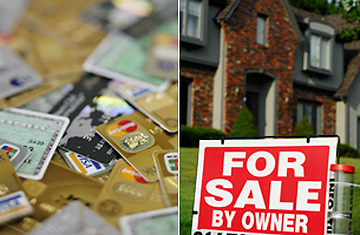
Poor credit? It's still no problem for some lenders.
The financial crisis was supposed to ring the death knell for companies that make loans to people who have had problems with debt. But a year and a half later, so-called subprime lending is alive and well. What's more, fears that increased regulation following the credit crisis would dramatically curtail the profits of these lenders is receding. A deal struck in the Senate would reportedly dramatically weaken a proposal meant to crack down on so-called payday lenders and other specialty finance firms that cater to people with lower credit scores.
Though there are soft spots in the subprime market, overall, business is good. The percentage of auto loans going to people with poor credit, for example, has been increasing. And while a number of banks have stopped offering credit cards to the debt-challenged, there are still companies handing out subprime plastic. First Premier Bank, for one, just tweaked the fees on its credit cards aimed at individuals with low credit scores to comply with recent legislation, and its business proceeds apace.
Some things have changed since the credit crisis broke. "Large banks have at least temporarily backed out of this business," says Chris Kukla of the Center for Responsible Lending, which tracks predatory lending. "But in the fringe financial business, there are plenty of firms that are willing to take advantage of subprime borrowers' difficulties accessing credit."
The lone exception is housing. Mortgage brokers say it is still hard for individuals with bad credit to get home loans. The subprime home loan market peaked in 2005, according to the publication Inside Mortgage Finance. That year, thousands of lenders and mortgage brokers handed out $625 billion in mortgages to borrowers with low credit scores, which is generally anything below 650. The credit crunch, though, put most of those firms out of business. Last year, financial firms made just $4 billion in home loans to people with poor credit. That number excludes loans backed by the Federal Housing Administration (FHA), which traditionally has helped troubled borrowers get mortgages.
But even the home lender of last resort is increasingly ditching those with low scores in favor of people with better credit. In the last seven months of 2009, the most recent data available, the FHA, which doesn't make its own loans but provides insurance for lenders that do, backed just $8.3 billion in loans to borrowers with a credit score of 619 or worse. That's down from $39 billion in the same time period a year before.
"We're back to where the subprime market started out 25 years ago," says Inside Mortgage Finance's publisher, Guy Cecala. "If you can't put 30% down on your house, you're not going to get a loan."
In auto lending, however, bad credit doesn't seem to be a hindrance. Slightly more than 36% of the car loans made by banks and finance companies in the fourth quarter of 2009 were to subprime borrowers, according to Experian Automotive, up from 34% in the third quarter. Still, borrowers have to pay more to get those loans. The interest rate on loans to finance purchases of used cars for buyers with credit scores of 550 or less climbed to nearly 18% at the end of last year. That's nearly 2 percentage points higher than those same customers were being charged a year ago.
Initially, many thought the financial crisis would be disastrous for subprime lenders, but that just hasn't panned out. One reason is those big banks that left the playing field. As more and more banks tightened their credit standards in 2008 and '09, the smaller lenders to people with poor credit have been able to not only pick up that business but also raise interest rates, since borrowers have fewer options. Shares of many of the companies, including Cash America, Dollar Financial, First Cash Financial and World Acceptance, have risen sharply this year. World, one of the biggest, has seen its stock price rise to a recent $41 from $15 a year ago. World makes much of its money refinancing its existing customers into new loans with longer terms and lower monthly payments. But last year, it also increased lending. At the end of 2009, World had $839 million in outstanding loans, which average about $800 each. That was up from $736 million in loans a year before.
Credit cards, too, are still available for customers with credit scores in the 600s and below. First Premier Bank used to charge customers with poor credit as much as $250 in fees to open a credit card that had a $300 limit. But following the recent passage of new rules for card issuers, which among other things caps the annual fees companies can charge to 25% of the credit limit, Premier has retooled its offering. It now charges a $45 processing fee before customers open a card. It then charges a separate $75 annual fee, which is exactly 25% of $300. "Getting a credit card if you have bad credit is harder than it used to be," says Odysseas Papadimitrou, CEO of consumer-credit website Card Hub. "But they are still available."
